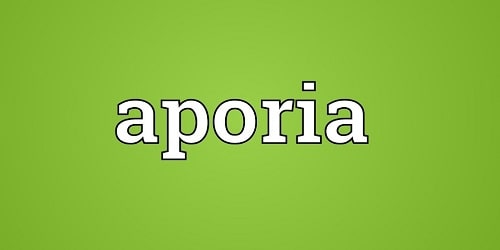Aporia Meaning
The word aporia (or aporima) has its origin in the Greek language. It comes from ἀπορία, the word integrated by the prefix: α (a) which translates as “without”, referring to a denial or absence; and by πόρος (póros) which means “exit” or “passage”. Literally, an aporia is that which has no way out, because in itself, it contains a contradiction.
Synonyms of aporia: Dichotomy, contradiction, paradox, and insurmountable difficulty.
Aporias are made up of contradictory propositions, which appear irrational or meaningless, and leave no possibility of finding a solution that provides light to the dilemma, yielding conclusions that are senseless. The aporias can be temporary until they can be resolved.
The Greek philosopher, Socrates (470 BC-399 BC) uses maieutics as a means to arrive at the truth. To do this, he uses questions that he asks his disciples, who must respond according to his beliefs, which Socrates tries to contradict, so that they question his own thoughts, causing them to fall into an aporia.
Zeno of Elea (490 BC-430 BC) was a Greek philosopher, famous for his paradoxes or aporias, on topics such as the plurality of entities, wanting to demonstrate that there is only one; and about the movement, which he tried to deny. To demonstrate his “truths” he starts from the opposite hypotheses, showing his inconsistencies, in order to verify, in this way, that the opposite ones, which are his, are correct. This form of proof is called “ad absurdum.”
One of his most classic and popular aporias is that of “Achilles and the Tortoise”, where, to prove that movement is just an illusion, he states that, in a race, the slowest runner (the tortoise) who has been given an advantage, it cannot be reached by the fastest runner (Achilles), since the latter, upon reaching where the tortoise is, will not be able to catch up with it, since it will have already advanced a little further.
Another aporia, that Zeno uses to deny movement, is that of the arrow that is heading to hit the target. Zeno affirms that she is at rest because if we take each of the moments of her movement, she is in a specific place; and then he concludes that movement cannot be the result of a sum of rests.
A current example of aporia can be found when talking about virtual reality, since it seems a contradiction that something is, at the same time, real and virtual.
Aporia Meaning in Hindi
अपोरिया (या अपोरिमा) शब्द की उत्पत्ति ग्रीक भाषा में हुई है। यह ἀπορία से आया है, जो उपसर्ग द्वारा एकीकृत शब्द है: α (a) जिसका अनुवाद “बिना” के रूप में होता है, जो इनकार या अनुपस्थिति को संदर्भित करता है; और πόρος (पोरोस) जिसका अर्थ है “निकास” या “मार्ग”। शाब्दिक रूप से, अपोरिया वह है जिसका कोई रास्ता नहीं है, क्योंकि अपने आप में, इसमें एक विरोधाभास होता है।
अपोरिया के समानार्थक शब्द: द्वंद्व, विरोधाभास, विरोधाभास और दुर्गम कठिनाई।
अपोरिया विरोधाभासी प्रस्तावों से बने होते हैं, जो तर्कहीन या अर्थहीन लगते हैं, और दुविधा को हल करने के लिए कोई समाधान खोजने की कोई संभावना नहीं छोड़ते हैं, जो निष्कर्ष को अर्थहीन बनाते हैं। अपोरिया तब तक अस्थायी हो सकते हैं जब तक कि उन्हें हल नहीं किया जा सकता।
यूनानी दार्शनिक, सुकरात (470 ई.पू.-399 ई.पू.) सत्य तक पहुँचने के साधन के रूप में मैयूटिक्स का उपयोग करते हैं। ऐसा करने के लिए, वह अपने शिष्यों से पूछे जाने वाले प्रश्नों का उपयोग करते हैं, जिन्हें उनकी मान्यताओं के अनुसार उत्तर देना चाहिए, जिसका सुकरात खंडन करने का प्रयास करते हैं, ताकि वे उनके अपने विचारों पर सवाल उठाएँ, जिससे वे अपोरिया में पड़ जाएँ।
एलिया के ज़ेनो (490 ई.पू.-430 ई.पू.) एक यूनानी दार्शनिक थे, जो अपने विरोधाभासों या अपोरिया के लिए प्रसिद्ध थे, जैसे कि संस्थाओं की बहुलता जैसे विषयों पर, यह प्रदर्शित करना चाहते थे कि केवल एक ही है; और आंदोलन के बारे में, जिसे उन्होंने नकारने का प्रयास किया। अपने “सत्य” को प्रदर्शित करने के लिए वह विपरीत परिकल्पनाओं से शुरू करते हैं, अपनी असंगतियों को दिखाते हैं, ताकि इस तरह से सत्यापित किया जा सके कि विपरीत परिकल्पनाएँ, जो उनकी हैं, सही हैं। प्रमाण के इस रूप को “एड एब्सर्डम” कहा जाता है।
उनकी सबसे क्लासिक और लोकप्रिय अपोरिया में से एक “अकिलीज़ एंड द टॉर्टोइज़” है, जहाँ, यह साबित करने के लिए कि गति केवल एक भ्रम है, वह कहते हैं कि, एक दौड़ में, सबसे धीमे धावक (कछुआ) को जो लाभ दिया गया है, वह सबसे तेज़ धावक (अकिलीज़) तक नहीं पहुँच सकता है, क्योंकि बाद में, जहाँ कछुआ है, वहाँ पहुँचने पर, वह उसे पकड़ नहीं पाएगा, क्योंकि वह पहले से ही थोड़ा आगे बढ़ चुका होगा।
ज़ेनो द्वारा गति को नकारने के लिए इस्तेमाल किया जाने वाला एक और अपोरिया, तीर का है जो लक्ष्य को मारने के लिए आगे बढ़ रहा है। ज़ेनो पुष्टि करता है कि वह आराम कर रही है क्योंकि अगर हम उसकी गति के प्रत्येक क्षण को लें, तो वह एक विशिष्ट स्थान पर है; और फिर वह निष्कर्ष निकालता है कि गति आराम के योग का परिणाम नहीं हो सकती है।
आभासी वास्तविकता के बारे में बात करते समय अपोरिया का एक वर्तमान उदाहरण पाया जा सकता है, क्योंकि यह एक विरोधाभास लगता है कि कुछ एक ही समय में वास्तविक और आभासी है।

